
So you wrote an excellent, well-researched blog post. Kudos to you! But you notice that the views aren’t piling up quite as you had hoped. What gives?
use SEO strategies to increase traffic to your website
Inbound marketing endeavors to put your brand front and center with authoritative and useful content to entice any reader – that is, potential customer – who seeks out information within your business space.
If you have authoritative and helpful content but don’t show up anywhere near front and center, what have you really accomplished? Zilch. That's why you need to optimize your content for maximal exposure on search engines.
The thing is, search engines are a lot like people; they don’t like being manipulated. A search engine best serves its users when it turns up the type of things that people want to see. To do this, it operates according to specific rules and implements certain heuristics when crawling the internet to index the mess of information.
Tasked with mapping the thick jungle of the internet, search engines look to identify what might be valuable to whom. These context clues include:
- Readability:
How sophisticated is the language on the page? Is it too difficult for most readers?
- Responsiveness:
- Originality:
Is the content featured on the page duplicated elsewhere? If it’s a copy-paste job, you’ll be flagged and penalized by search engines.
- Repetition of key terms:
Words that appear on a page repeatedly and in similar arrangements tell search engines the focus of the writing. (Key for relevance-based indexing.)
- Historical popularity:
The more people visit a website, the more confidence a search engine can have in understanding that this is what people are really looking for.
- Internal and external links:
Are people referring to your pages as references for their own content? Do you credit the sources used in your content? These are essential factors in building the credibility of your domain and giving people easy access to your pages.
- Quality of references:
If you use a statistic in your content and link back to a friend’s Facebook note as your source, it doesn’t build much credibility. Likewise, if a link to your page appears on Yahoo! Answers it doesn’t mean as much to a search engine as it would if it appeared in Forbes.
- Image use:
People like pictures, and search engines know that. It also speaks to the effort invested in the piece and suggests a level of quality.
Naming conventions (Alt-text) and any information stored on the backend of the image file matter a lot.
Search engines are looking for any clues they can find, so invest in all the details. If your low-resolution image gives your page a distinctly outdated feel, chances are it’s not helping as much as it could.
SEO: The Logic
 All rules have loopholes and all heuristics fail in the face of situational complexity. Those gaps in the system constitute the wiggle room with which we marketers try to advance our content. Seizing the oddities of search engine logic, we can artificially boost our visibility to those engines. That added visibility leads to greater exposure.
All rules have loopholes and all heuristics fail in the face of situational complexity. Those gaps in the system constitute the wiggle room with which we marketers try to advance our content. Seizing the oddities of search engine logic, we can artificially boost our visibility to those engines. That added visibility leads to greater exposure.
Search engine developers and search engine optimizers are fundamentally opposed. Developers want to create a tool that offers objective insight, while optimizers want to exploit vulnerabilities in the tool’s design to skew its insight subjectively.
When an exploitable algorithmic dimension is taken advantage of – distorting the search results to no longer accurately reflect user preferences – the big brains at Google quickly get to work to close the gap and return the system to order.
It’s a game of cat and mouse. For marketers, though, it’s all about leveraging that back-and-forth. While optimization techniques based on defined algorithmic dimensions are fleeting by nature, you can move from one technique to the next and make a big difference for your clients in the interim.
It All Starts With A Great Keyword Strategy
Are you still with me? I know this can be a bit much, but focus. I promise you’re only a few words away from SEO gold. With all those different SEO elements mentioned above – images, readability, repetition, links etc. – it’s fair to wonder where to start.
You needn’t wonder anymore. Without a doubt, your starting point needs to be your key terms – also known as keywords.
What goes into an excellent keyword strategy? For starters, you shouldn’t have a page-by-page keyword strategy; you should have an overarching keyword strategy – implemented with each new page.
You should have a large pool of ready-to-go keywords from which to draw for each and every page on your website and blog.
These keywords should all be interconnected and partly overlapping. They should be vetted for relevance, opportunity, and difficulty. That way, with each new page of content, you’re cumulatively building to your goal of great SEO.
How To conduct keyword research strategy in 11 easy steps
1. Keyword Research: Find the keywords that are right for you
The first step is obviously to find the right keywords.
There are a ton of tools out there to help you find the best keywords (or terms or phrases) that'd you want to use. Some of them, like Ahrefs, SEMRush, and Moz are subscription-based (but offer free trials) and there are a couple that are free. The best free ones are Google's Keyword Planner and Ubersuggest.
Here are some examples from Ahrefs.
The first step is to type in the keywords that you want to look for. Let's use "enterprise security" as an example.
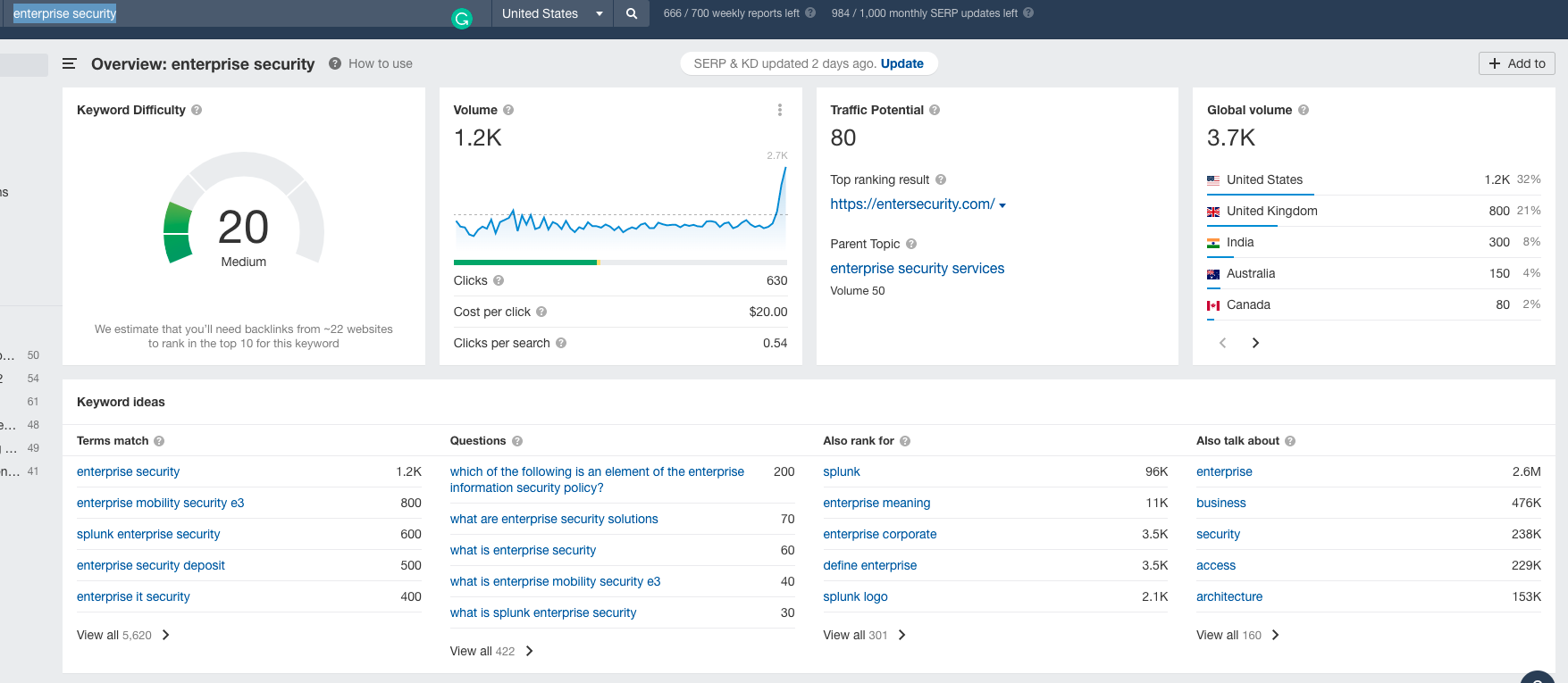
Now let's review the results.
2. Review results:
Right away there are several things you should take into consideration:
- Keyword Difficulty - This is an estimation of how hard it would be for your website to rank in the top 10 for this keyword. In this example, the difficulty is 20 which is Medium, so there might be some potential.
- Volume - This gives you the average monthly searches in the country chosen (in this case, the USA) for the keyword in the last 12 months & the graph shows you the trend. So in this case, you can tell that there are on average 1,200 monthly searches for "enterprise security" and that the overall monthly trend is going up. (This is good).
- Cost & Clicks - Underneath the volume, you can see the average CPC for that keyword (meaning, how much you'd have to bid to run ads for that keyword on Google Ads) as well as how many clicks there are for that term. That means, that on average, out of the 1,200 monthly searches, 630 of these end up clicking on a page in the search result. This gives you an indication of how the search result page (known as SERP) is, as well as what the user intent is. For example, if we were to search for "time in India", we'd see that the clicks would be much lower. That's because Google shows a Knowledge Panel that illustrates the time right on the SERP page, so very few people would actually click on a result page.
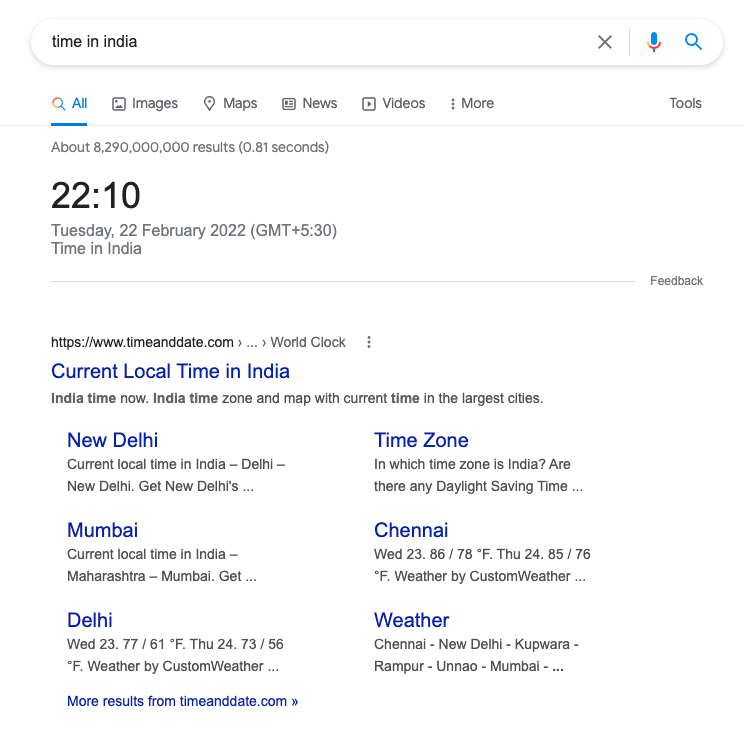
Why click on a page when Google shows you the answer right in the SERP? This format of answering questions directly on Google is called "Knowledge Panel". This is why when doing keyword research, you shouldn't look just at traffic volume - but also take into account the SERP, click potential, difficulty, and user intent. - Traffic Potential - Traffic potential gives you an estimation of how much traffic you should expect to get to your page from the keyword.
- Global Volume - While you may want to focus on a specific market, this bar graph shows you how much people in different countries search for this term. If your topic is general and not country-specific - this is something you should consider as it can increase your traffic.
- Keyword Ideas Bar - This bar gives you keyword ideas. Here you can look at keywords or content ideas. Clicking on "view all" would give you even more potential keywords.
3. Look for problems/opportunities:
It’s your industry and you know it. Remember that. It’s a brave new world with the complexities of the internet, technology, and digital marketing, but it’s vital that you not abandon your intuition and instincts. In most cases, they’ll prove the most powerful tools in your arsenal for a great keyword strategy.
When looking at the keyword list results, you need to take into consideration the buyer persona. Are these keywords relevant to the people you'd want to target?
Review the keyword lists that you came up with.
Try to locate keywords that ideally have:
- High volume
- Low Difficulty
- High click potential
- Search trend is not declining
If you see keywords that fit that description - bingo! Those are the first you'd want to target.
Unfortunately, most keywords are not like that. So there will be some balancing of pros and cons to different keywords that you'd want to consider before deciding on specific keywords.
4. Export Your Results To A Spreadsheet:
Export your keywords into a spreadsheet, and then you can decide on specific keywords based on different metrics.
Consider what would be the most important thing to your company. Some things to consider:
-
Is your website brand new, and does it have very few links to it? In that case, your overall website score would be lower. In this case, ranking for keywords with medium to hard difficulty scores would be much harder. If you have a well-established website, you'd have more chances to crack into harder terms.
-
Are you building a long-term keyword strategy where you'll be publishing regular blogs or looking for keywords for several key pages on your pages? If you're building a long-term strategy, you can create specific posts for different subtopics. If you're looking for terms for several key pages, you'd want to pick only keywords that are relevant to each other.
-
Volume vs traffic - As a general rule, keywords with lower volumes would be easier to rank for since fewer websites would be competing for them. This means that newer websites have an easier time getting ranked for these pages quickly. So if you're looking for quick results and traffic - perhaps targeting several low-volume, low-difficulty keywords would make sense. However, if you have the time and resources to play the long-term game, then perhaps focusing on several high-volume, more competitive keywords would make more sense.
These are just some of the questions that you'd want to ask yourself (and your team) when choosing a keyword strategy.
These questions are not always straightforward and should be considered as part of your overall inbound marketing strategy.
Balancing these questions can be difficult, and our team of marketing experts can help you consider and balance the different considerations.
5. Check your competitor's keywords:
As part of your keyword research, you should consider the keywords that your competitors are targeting. This would also help you find new topics that you have perhaps not considered.
If you're using Ahrefs, go to the "Site Explorer" section.
This allows you to get data on any website.
Enter the URL and voila!
When we searched for "Zonal Architecture" (a relatively new term in the automotive industry) the first result was from guardknox.com, so let's check out their website:
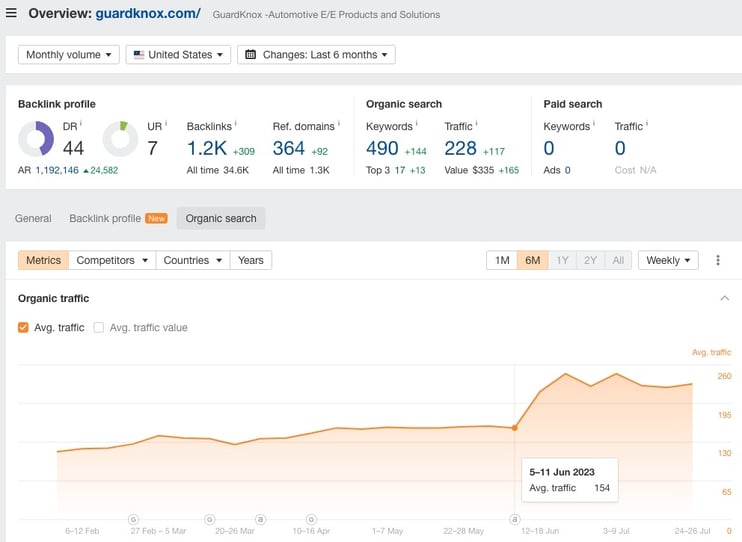
The first thing that you can see is that this site has a Domain Rating of 44, which is a good score for a B2B tech website. We can also see that this site has been experiencing increased organic traffic in the last six months. Nice 👍.
If you click on the "organic keywords" section, you'd be taken to a section that, surprise, surprise, would show you the organic keywords that the website ranks for.
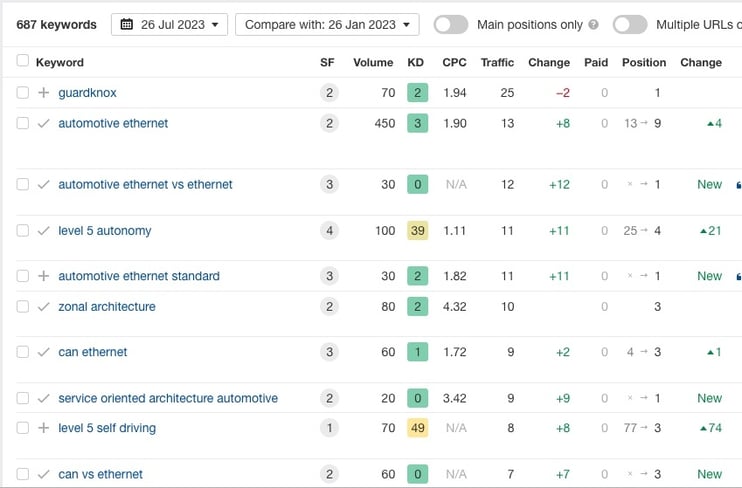
In this case, you can see that Guardknox is experiencing an improvement in ranking for many keywords - it seems like they invest in good B2B SEO services.
(example: "level 5 delf driving" keyword jumped 74 places up to position 3, this is a impressive achievement)
6. Loot!
You know the old phrase, right? “All’s fair in love and SEO." Take whatever you can from your competitors’ lists. Add any attractive (relevant) and attainable (underused) target keywords to your database.
Here too, you should export your competitor's keywords into Excel, and then you can compare them vis-a-vis your own or your previous keyword research.
I like to keep things methodical, so I usually have separate Excel tabs for my original keyword pool, my competitor-derived keywords, and the consolidated list.
7. Keep it in the family:
Using your list of keywords, taken from your own site/intuition and expanded courtesy of the competition, you should now begin organizing it. Sort all of the keywords you have into categories – or Logical Keyword Families. (LKFs) I like to do this in a fourth tab.
These Logical Keyword Families (LKFs) should be based on your core competencies and/or industry-relevant subjects. The number of LKFs according to which your database is segmented will depend on the size and complexity of your product/service offering. As a rule of thumb, aim to build out at least four families (a.k.a topic clusters).
For Penguin Strategies, it could be inbound marketing, marketing automation, HubSpot implementation, and outsourced digital marketing agency. Each one of those things may have a lot to do with the others, but they remain disciples unto themselves – hence a Logical Keyword Family.
Every single keyword phrase in your database should be assigned to one of your LKFs. If you can’t figure out where one of your keywords rightly belongs, that’s normally a good indication that you should create a new LKF.
These categories will prove helpful in mapping out your content strategy and can also fall in line with your buyer personas and buyer’s journey stage segmentations.
8. Don’t forget to clean up!
Now you have a pretty considerable keyword pool organized for efficient implementation. But just because your keywords are relevant doesn’t mean they’re strategically viable.
Filter out the impractical and illogical keywords. For Penguin Strategies, a keyword such as “B2B marketing” would be impractical. There are too many more prominent players already entrenched around that phrase. We could never compete with the likes of HubSpot. (Good thing we’ve teamed up with them!)
Again, taking into consideration keyword difficulty here would be helpful.
Another thing to consider when removing keywords is the user's intent. You can use the potential clicks as a metric here as well. But put yourself in the eyes of your buyer personas: if they type that query - what would they be looking for?
As we've seen above, queries that are usually very specific (such as the time example), would usually be answered on Google directly, and therefore would probably have low volume for your buyer's journey.
9. Fill in the gaps:
Logic and intuition aren’t only good for removing keywords; they’re also good for adding them. Go over the list and manually add keyword options that are absent but make sense based on your marketing goals and buyer persona interests.
Add strategically significant phrases. Even if the phrase is very particular, if it’s something that a potential customer is likely to search for, it wouldn’t be a great keyword strategy without it on your list.
Many SEO experts stress building your keyword strategy around terms with low difficulty and high average monthly searches, but they’re too focused on the marketing side to see the sales side tie-in.
Even if only 15 people search a phrase a month, if those 15 people are serious about a product/service such as yours, it’s totally worth developing content for them.
Those niche visitors are easily converted into quality, qualified leads. Depending on your product or service, a single new customer can more than cover your added content costs.
10. Check Google and refine:
AHREFS (and other SEO tools) lets you see the search result page when conducting keyword research.
Here is another example of a new 2024's popular search term, "Addressable TV advertising" (taken from the TV industry) we can see these results:
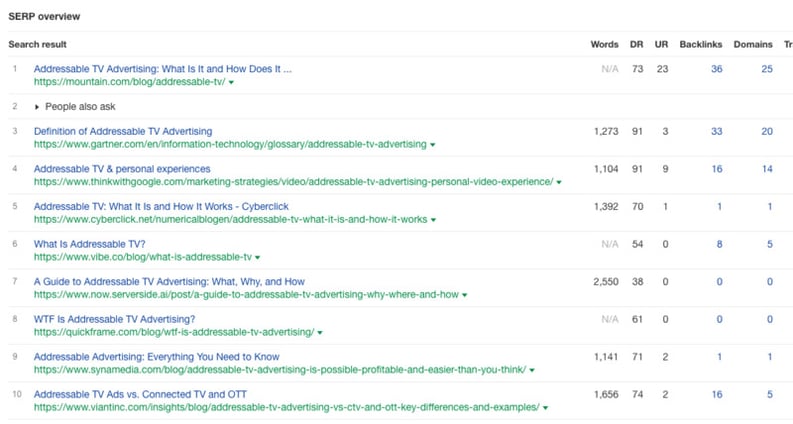
This ranking information is accurate because Google tries to adopt the search results for each user. If you search for a term and click on a link, there is a good chance that the next time you will run the exact search, the website you visited will rank higher (just for you).
You can also see the "People Also Ask" section that appears on Google. This is important to consider when planning out your content, as it gives you insight into what people are interested in when searching for these keywords.
You should go ahead and check the pages that come up in the top position. What kind of content do they have? Is it primarily graphs and data? Or long-form detailed discussion?
Try to understand and find what is missing from their content - or how you can create content that is even better. This would help you rank better.
For an insight into the actual searches that people are running, type your keywords into Google and see what auto-complete suggests. This could be a great way not just to round out your keyword strategy but also to tell you the specific angles to take when drafting content.
11. Prioritize the list:
Now that you've done your keyword research, looked at your competitor's keywords, and read the best-performing content on the topic - the only thing left is to prioritize the list.
Remember that your keyword strategy needs to be relevant and aligned with your overall marketing strategy.
Prioritize the different keywords, and now you can start creating content according to your list.
Remember that as your organization grows and its marketing strategy matures, your keyword strategy should, too. Your keyword database needs to be continually updated.
If you launch a new product, it needs to be reflected in your keyword strategy. The same goes for changing your branding or developing a new core competency.
Conclusion: Your keyword Strategy in 2024
Don’t misunderstand me – a great keyword strategy is not a one-and-done SEO solution. SEO is an infinitely complex discipline. That said, without this type of keyword database, you’d be hard-pressed to get anywhere. This is the starting point, and with it, the sky’s the limit.
If you need help or have questions about creating the best keyword strategy, our SEO experts would be happy to assist you.

by Ido Yitzhaki on February 24, 2022
Director, Head of SEO/PPC business unit @Penguin. Expert in B2B SEO and PPC services and a Wood-Badge scout ⚜️






